MSI GeForce GTX 970 Gaming 4G Graphics Card Review

We have taken a look to one of a gamers’ dream graphics card based on new Nvidia Maxwell chip. And it’s unbelievable, but we cannot find any drawbacks in MSI GeForce GTX 970 Gaming. And now we will try to convince you of its advantages.
September 19, Nvidia introduced its second batch of GPUs with the Maxwell architecture along with two graphics cards that use them: GeForce GTX 980 and GeForce GTX 970. The first batch included the GM107 GPU and the GeForce GTX 750 Ti card, but now we have top-end products with much higher performance. We couldn’t prepare a GeForce GTX 980 review at the time of its official release due to certain reasons beyond our control, so we will make our acquaintance with the new GPUs by using its original version, the GeForce GTX 970 Gaming model from MSI.
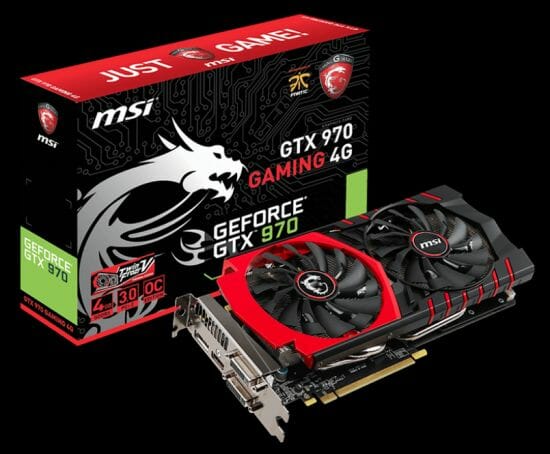
The flagship GeForce GTX 980 model with all of the architectural innovations will be covered in its reference version in our next review.
Specifications and Recommended Price
The specifications of the MSI GeForce GTX 970 Gaming are listed in the following table in comparison with the following reference cards: Nvidia GeForce GTX 980, Nvidia GeForce GTX 780 Ti, Nvidia GeForce GTX 780 and AMD Radeon R9 290X.
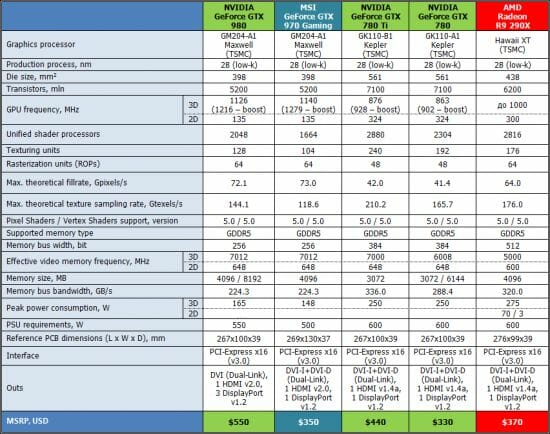
Packaging and Accessories
The MSI GeForce GTX 970 Gaming comes in a brightly colored box made of robust cardboard. There’s a picture of a dragon on the front of the packaging. We can also see a Gaming series logo, the card’s model name and memory amount, and the name of the cooling system.
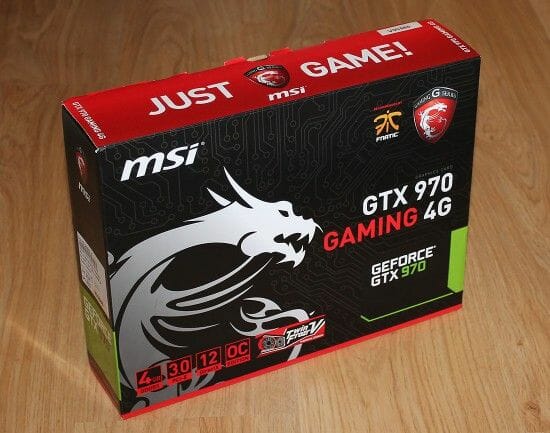
You can refer to the back of the packaging to learn about the product’s key features, specifications, system requirements and supported Nvidia technologies.
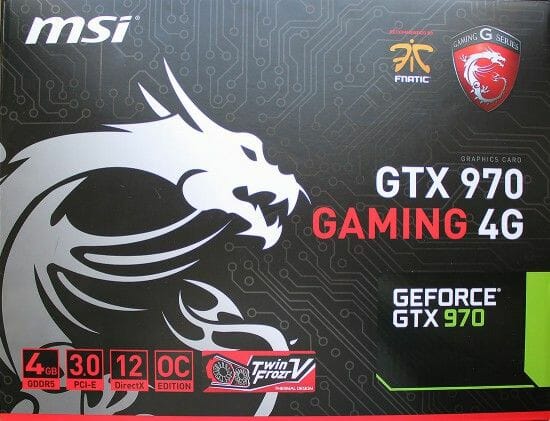
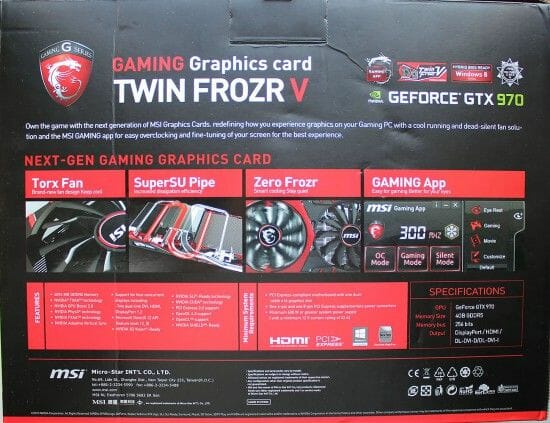
There’s a thin-cardboard box inside the colorful wrapper. The graphics card is fixed in its middle compartment within a piece of polyethylene foam that protects it during transportation.
The card’s accessories, packed into an additional flat box, include a CD with drivers and utilities, an installation guide, a promo booklet, a DVI->D-Sub adapter, a power cable, and a quality certificate.
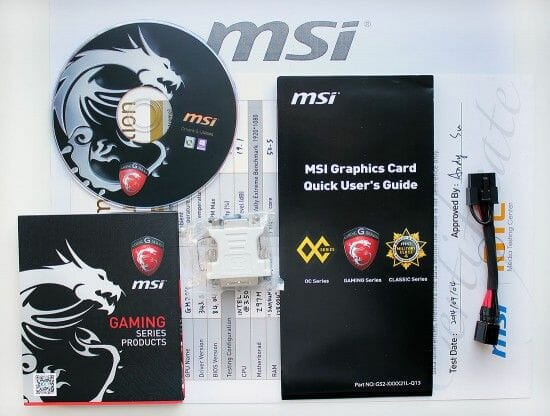
There are no bonus accessories, but what we’re dealing with is actually a prerelease sample of the card, so MSI may still add some extras like games or souvenirs.
Manufactured in China, it comes with a 3-year warranty. As for its price, the card wasn’t available in retail at the time of our writing this review, but we were assured it wouldn’t differ much from Nvidia’s recommended GeForce GTX 970 price ($329).
PCB Design and Features
The new GeForce GTX 970 Gaming differs considerably in its design from MSI’s previous products such as the MSI GeForce GTX 780 Ti Gaming. It looks lighter because MSI’s most advanced cooler, Twin Frozr V, has a plastic rather than metallic casing. We guess the new card is even more stylish than its predecessors, though.
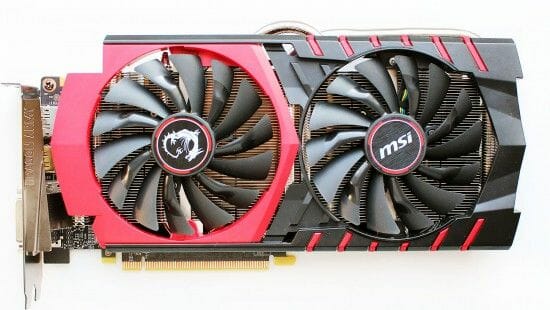
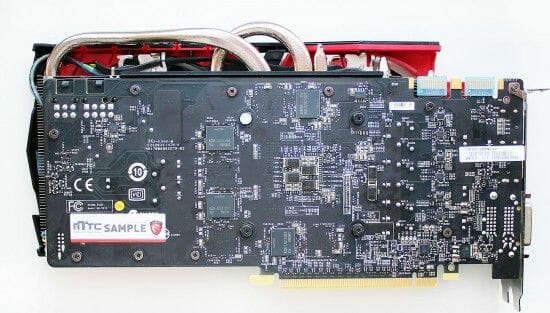
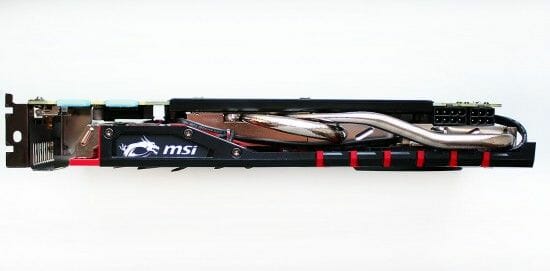
The dual-fan cooler covers the entire face side of the PCB. The fans have peculiar impellers we’ll discuss in the Cooling System section of our review. The cooler’s heat pipes can be seen sticking out at the top edge of the card. The reverse side of the PCB is exposed. The dimensions of the MSI GeForce GTX 970 Gaming are 269x130x37 millimeters.
The graphics card has dual-link DVI-I and DVI-D outputs, one HDMI 1.4a/2.0 connector, and a DisplayPort 1.2. There’s a vent grid in the mounting bracket to exhaust the hot air from the cooler.
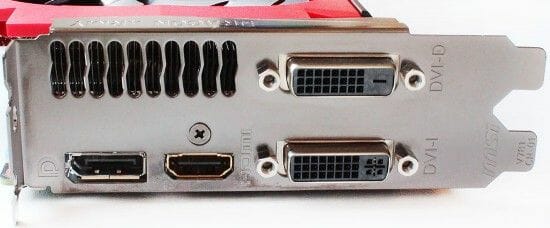
Most of the hot air will stay inside the computer case, but that’s not a serious downside for this particular graphics card as we will see shortly.
The GeForce GTX 970 Gaming has two connectors for building SLI configurations with up to four graphics cards. One of its two power connectors is of the 8-pin variety.
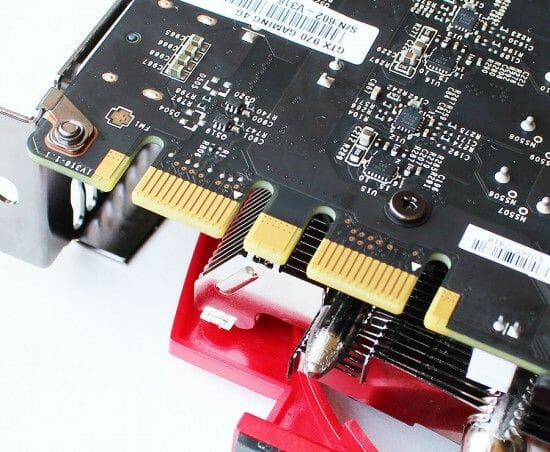
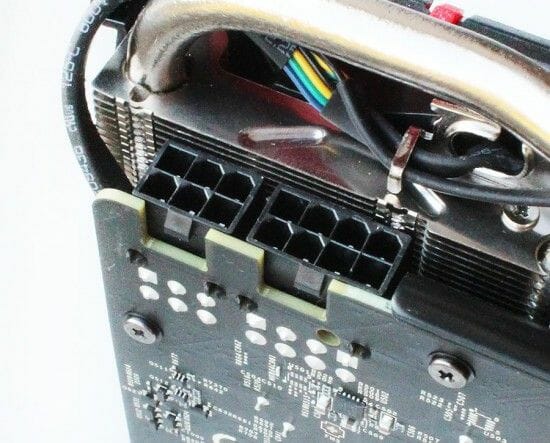
The card is specified to have a peak power draw of 148 watts, which is a mere 3 watts more than specified for the reference GeForce GTX 970. A 500-watt or better PSU is recommended for a computer with one such device inside.
The massive cooler is secured on the PCB with only four screws around the GPU, so we could remove it quite easily. Underneath, we saw a heatsink on power components and a heat-spreading plate on memory chips and other power components.
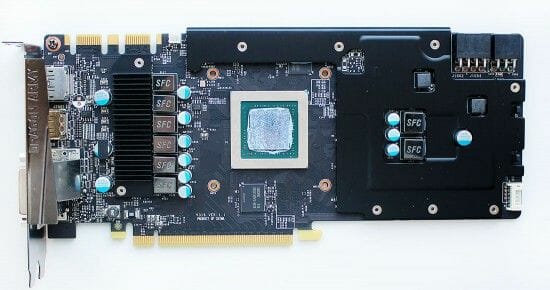
After we took those cooling elements off as well, we could see that the GeForce GTX 970 Gaming uses an original PCB. There are memory chips on both sides of the PCB with empty spaces for even more memory. We have no doubt we will see 8GB versions of the card in the near future.
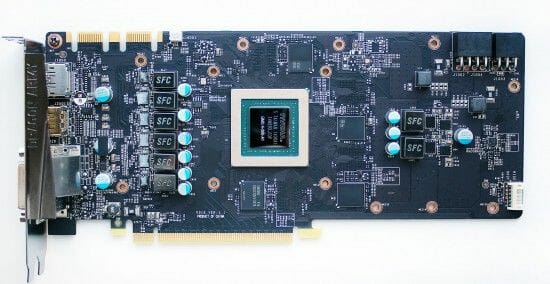
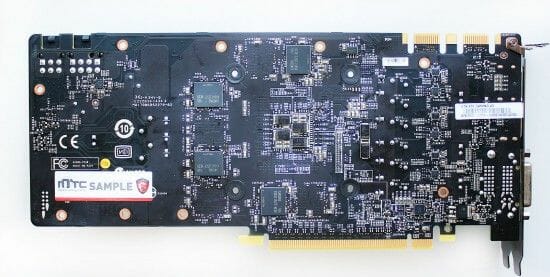
All of the card’s components comply with the American Military Class IV standard. The power system uses aluminum-core solid-state capacitors with ultra-low resistance and 10-year service life, economical (93% efficient) Hi-c capacitors and Super Ferrite Chokes with 20% higher energy efficiency and 30% higher current capacity compared to ordinary chokes.
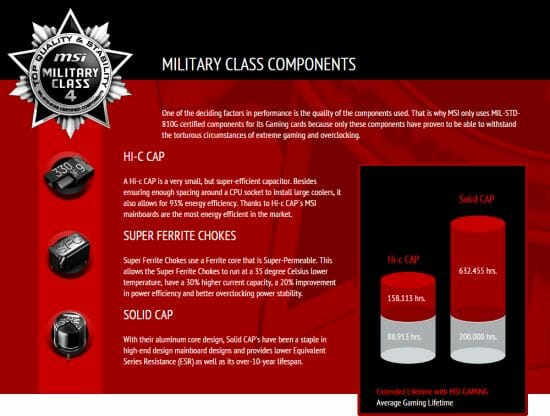
The power system consists of six phases for the GPU and two more (to the right of the GPU) for the graphics memory and PLL.
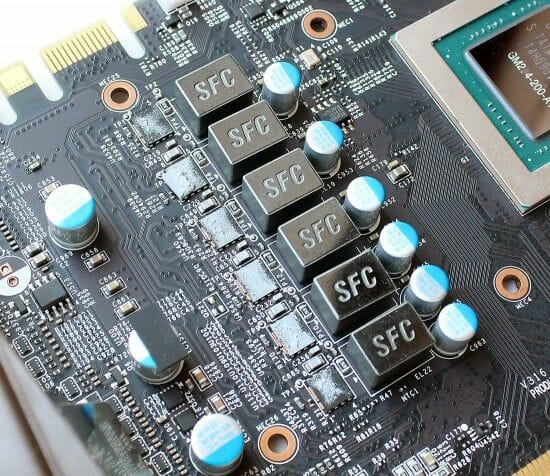
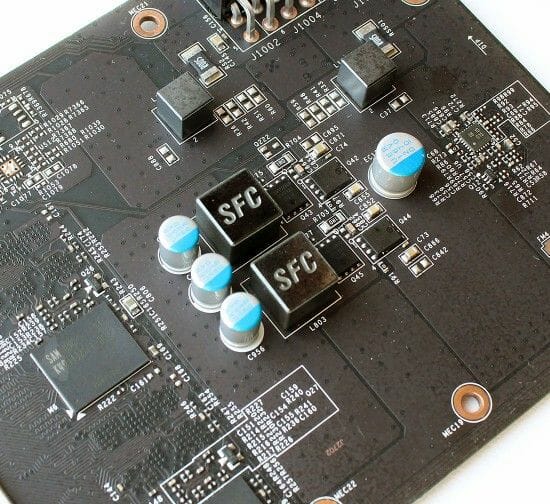
There are additional solid-state capacitors on the reverse side of the PCB opposite the GPU.
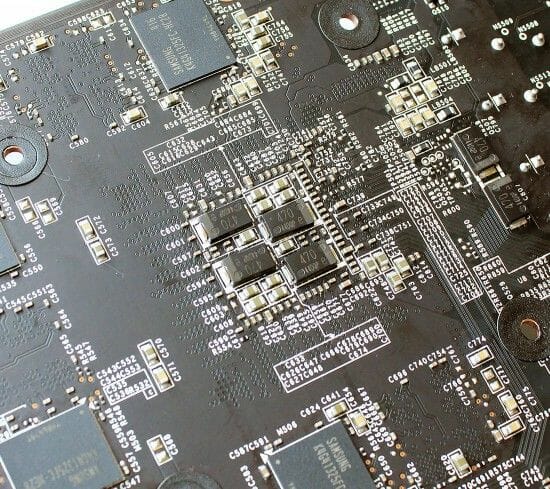
The MSI GeForce GTX 970 Gaming carries a revision A1 Maxwell-based GM204 processor. Judging by its marking, the 398 sq.mm die was manufactured in Taiwan on the 30th week of the current year (i.e. in mid-July).
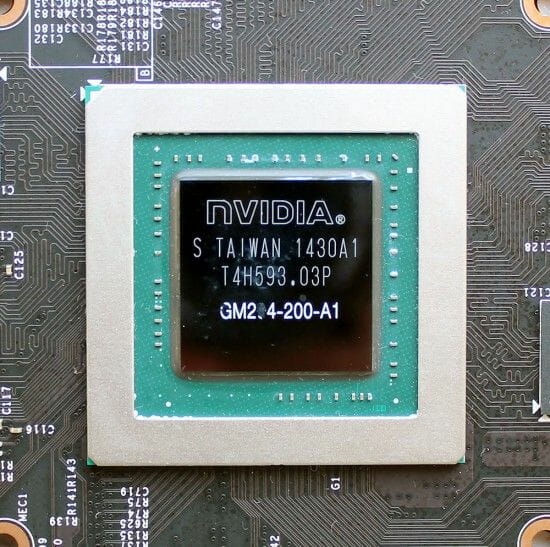
The GPU incorporates 1664 unified shader processors, 104 texture-mapping units, and 64 raster operators. The reference GeForce GTX 970 is clocked at 1050 MHz in 3D mode (boostable to 1178 MHz at high loads) but the MSI version is pre-overclocked by 8.6%: 1140/1279 MHz. The factory overclocking is quite substantial. We can even hope that the card has good frequency potential since most manufacturers don’t usually take any risks when overclocking their products and thus don’t reach the limit.
The GPU frequency is dropped to 100 MHz in 2D mode (compare this to the GeForce GTX 780’s 324 MHz) whereas the ASIC quality of our sample of the GPU is 62.3%.
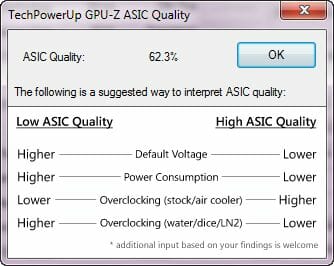
The graphics card carries four gigabytes of GDDR5 memory in eight chips located on both sides of the PCB. They are manufactured by Samsung Semiconductor and marked as K4G41325FC-HC28.
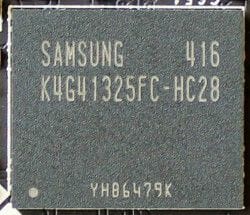
With an access time of 0.28 nanoseconds, such chips are rated for a clock rate of 7000 MHz. MSI didn’t overclock them, so the memory frequency of 7012 MHz, just like Nvidia’s reference sample. With a 256-bit bus, this ensures a rather high bandwidth of 224.4 GB/s. The memory clock rate is dropped to 648 MHz in 2D mode.
The latest version of the GPU-Z utility available at the time of our writing this is already quite familiar with the GeForce GTX 970.
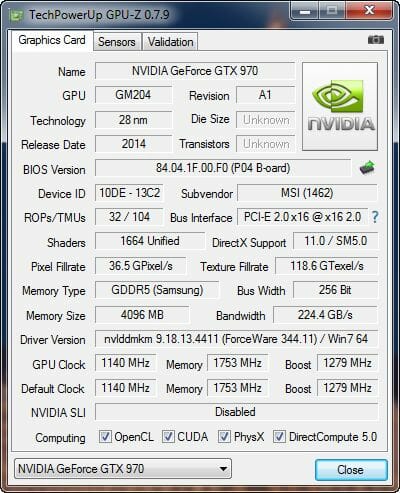
It couldn’t read the card’s BIOS, though. That’s why we don’t publish it here.
Cooling System: Noise and Efficiency
MSI’s announcement of the next-generation Twin Frozr V cooler almost coincided with Nvidia’s announcement of the new GPUs. As it was the case with the Twin Frozr IV, we are up to several modifications designed for graphics cards of different classes. The GeForce GTX 970 Gaming seems to use the most advanced modification, though. MSI claims the new Twin Frozr took 18 months to design and implement. The outcome is up to 10°C better than the Twin Frozr IV Advanced.
The cooler has a nickel-plated copper-base heatsink, copper heat pipes and aluminum fins.
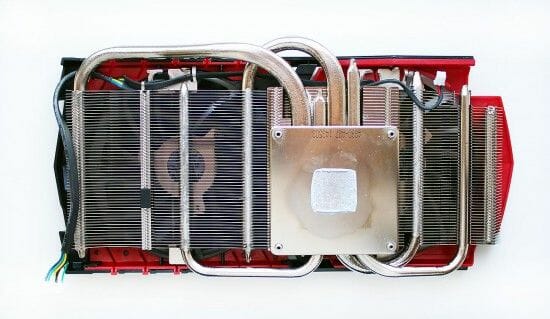
There are four heat pipes here: two are 6 mm and the other two are 8 mm in diameter. The pipes go alternating out of the base to different sides, piercing the whole of the heatsink.
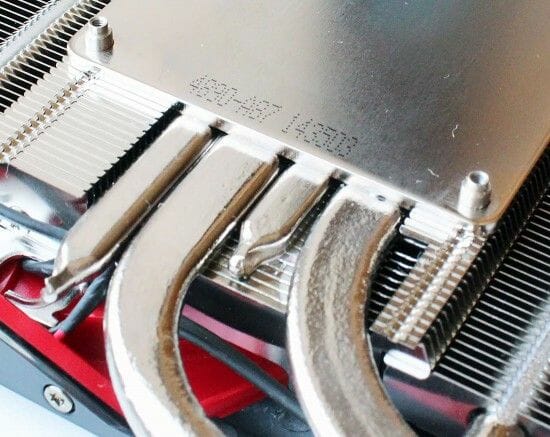
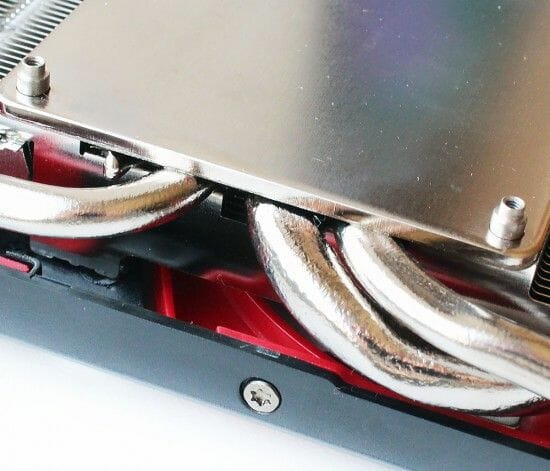
The heatsink and the pipes are soldered to each other, just as you may expect from a top-end cooler.
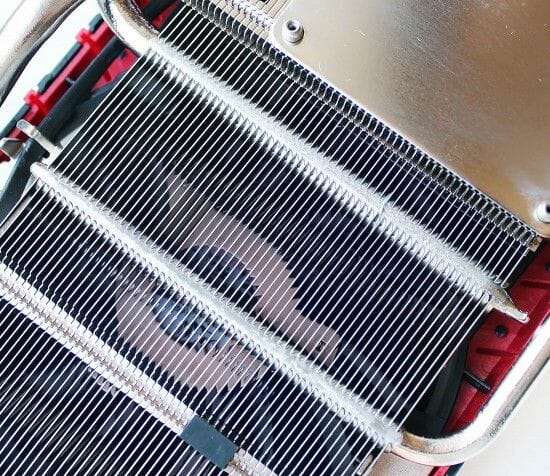
The thin aluminum fins are placed 1 mm apart from each other on the heat pipes. Frankly speaking, the heatsink seems to be unchanged, so let’s see what fans the new Twin Frozr V has.
The two 100mm Torx Fans are manufactured by Power Logic (the PLD10010S12HH model). The actual diameter of the impellers is 94 mm. The fans feature alternating blades which differ in their angle of attack.
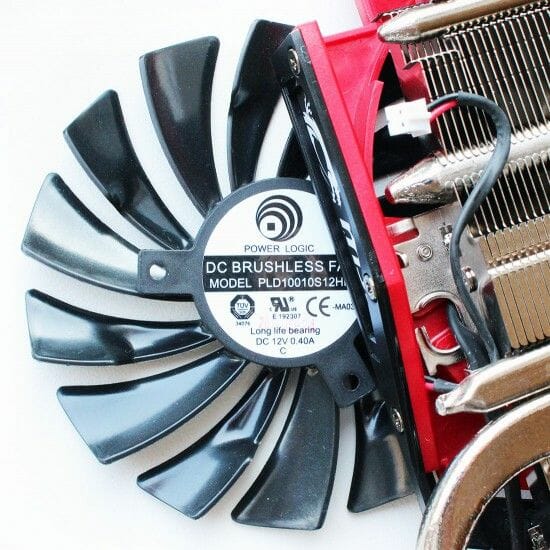
Thanks to the peculiarly-shaped blades and the increased number of them, the fans ensure increased air flow at a 5% noise reduction. The fan regulation algorithm has been optimized as well. The Zero Frozr technology means that the fans are halted altogether in 2D mode and at low 3D loads. Judging by monitoring data, they start working as soon as the GPU temperature hits 60°C. And they do so very smoothly, without a sudden acceleration as is often the case with other coolers. The fans run on sleeve bearings with increased service life.
The power transistors and memory chips on the face side of the PCB are cooled with an aluminum heatsink and a heat-spreading plate with thermal pads, respectively.
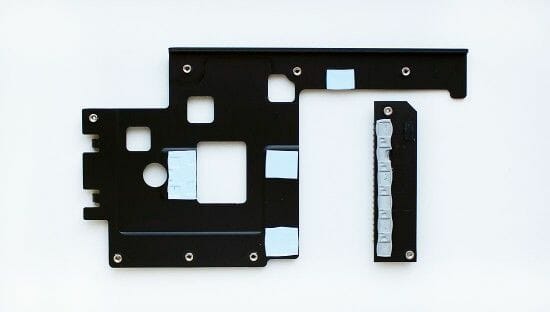
Modders will appreciate the highlighting of the Gaming series logo at the top of the cooler’s casing.
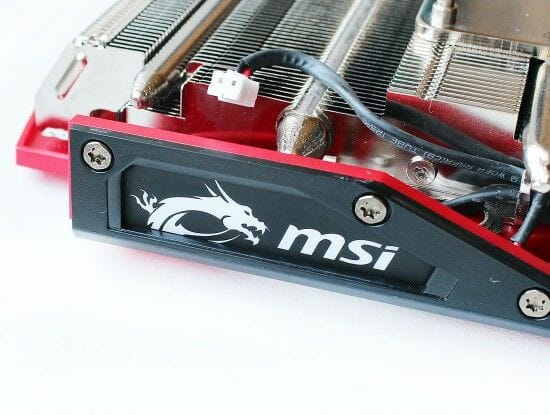
Just take a look at how splendid it is:
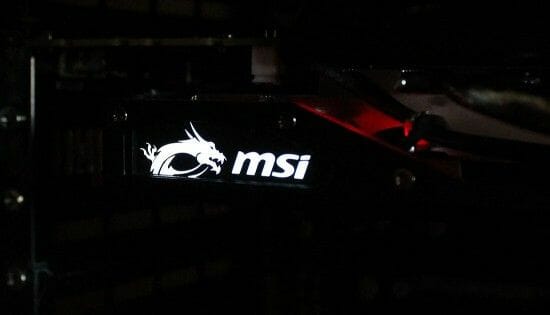
But of course, we are more interested in the cooler’s performance and noisiness rather than its beauty. So let’s check these properties out right now.
To measure the temperature of the graphics card we ran Aliens vs. Predator (2010) five times at the maximum visual quality settings, at a resolution of 2560×1440 pixels, with 16x anisotropic filtering and with 4x MSAA:
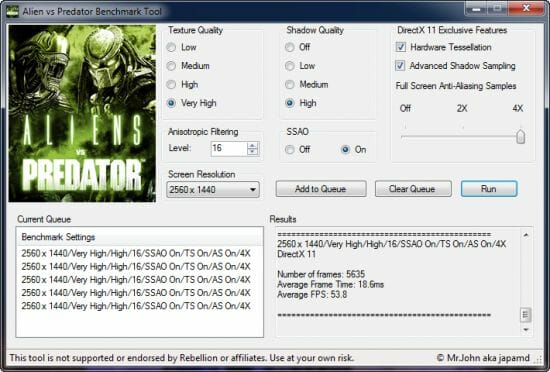
We used MSI Afterburner 4.0.0 and GPU-Z version 0.7.9 to monitor temperatures inside the closed computer case. The computer’s configuration is detailed in the following section of our review. All tests were performed at 20°C room temperature.
First we ran our MSI GeForce GTX 970 Gaming with its fans regulated automatically.
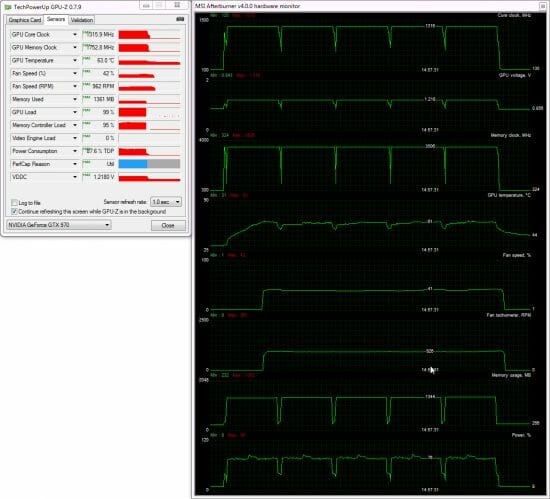
Besides the increased clock rate (1316 MHz in the boost mode), the monitoring diagram shows that the GPU temperature was steadily rising up to 60°C and only then the cooler’s fans switched into action. Their starting-up was imperceptible against the background noise of our quiet computer since their speed reached only 960 RPM (41% of their full) and stabilized at that mark. Considering that the card maintained that speed of the fans throughout our test and the temperature never rose above 63°C, the result is absolutely amazing.
Recalling our previous tests of top-end graphics cards, their coolers would only use their fans at 1000 RPM or thereabouts in 2D mode but now we see this fan speed maintained at a high 3D load. Of course, this result is not entirely due to MSI’s redesigned cooler or its fans. It is the energy-efficient Maxwell GPU that makes the trick with its low heat dissipation. MSI should be given credit, however, for making good use of that fact and developing a fan regulation algorithm which combines high cooling performance with a very low noise level.
When the cooler’s two fans worked at their maximum speed, the peak GPU temperature of the GeForce GTX 970 Gaming was hardly above 51°C.
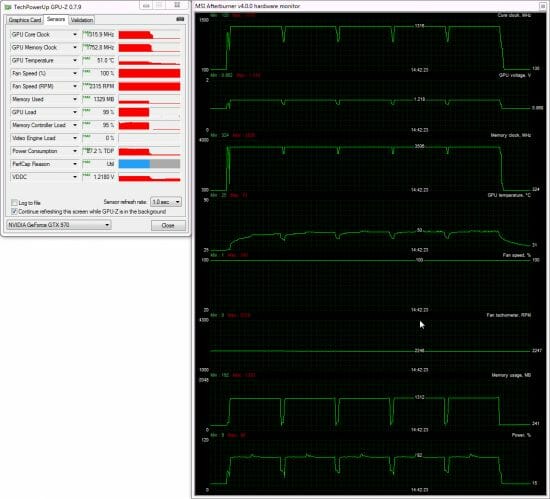
We guess that’s redundant for the GeForce GTX 970 Gaming, especially as the fans become audible (even though not really noisy) at the maximum 2300 RPM.
As for the noise level, we couldn’t measure it using our standard method because the card has a special type of the fan connector. We can only add that the card was very, very quiet in the automatic fan regulation mode and was absolutely silent in 2D mode. Its chokes didn’t produce any unwanted sounds, either.
Overclocking
With such a high-performance cooler and such an energy-efficient GPU, the GeForce GTX 970 Gaming couldn’t help delivering high overclocking potential. Indeed, we managed to accelerate its GPU from its default 1140 MHz by 185 MHz (+16.2%). The memory chips were overclocked by 1040 MHz (+14.8%).
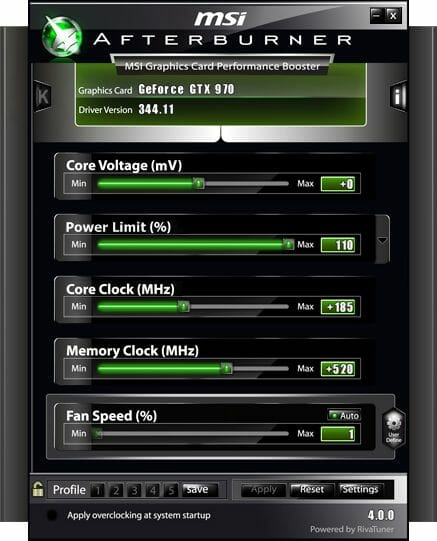
So the resulting clock rates were 1330-1469/8052 MHz.
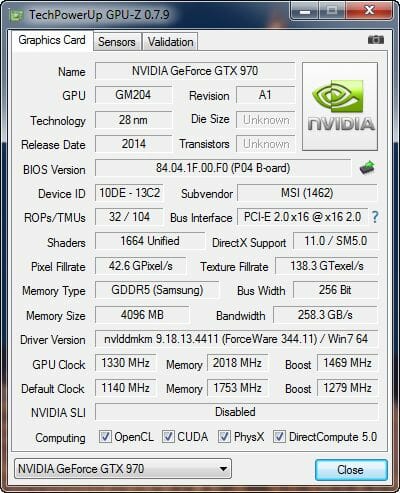
Moreover, our monitoring tools showed that the GPU clock rate was up to 1501 MHz in 3D mode!
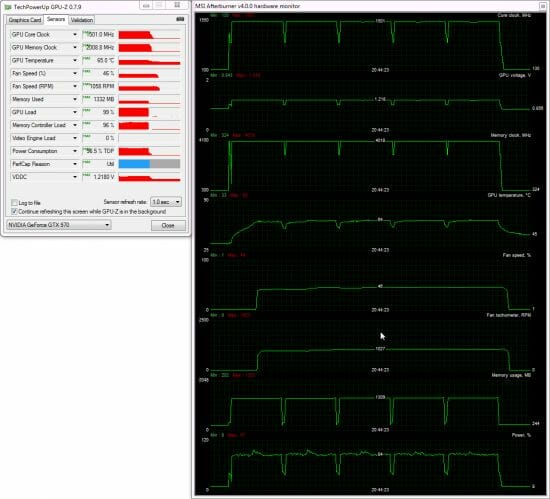
A GPU clock rate of 1.5 GHz is most amazing. It used to take liquid or even better cooling to reach such clock rates with earlier graphics cards. But now the MSI GeForce GTX 970 Gaming hits that mark with an air cooler working in complete silence because the fans would never accelerate above 1060 MHz. The GPU temperature reached 65°C during the first cycle of our test and stayed at that mark thereafter. All in all, the MSI GeForce GTX 970 Gaming is a graphics card with excellent overclocking potential and a most efficient cooler.
Testbed and Methods
The graphics cards are tested in a closed computer case that has the following configuration:
- Mainboard: Intel Siler DX79SR (Intel X79 Express, LGA2011, BIOS 0594 dated 06.08.2013)
- CPU: Intel Core i7-3970X Extreme Edition 3.5/4.0 GHz (Sandy Bridge-E, C2, 1.1 V, 6x256KB L2 cache, 15MB L3 cache)
- CPU cooler: Phanteks PH-TC14PЕ (2xCorsair AF140 fans, 900 RPM)
- Thermal grease: ARCTIC MX-4
- Graphics cards:
- Nvidia GeForce GTX 980 (4 GB, 1127-1216/7012 MHz)
- MSI GeForce GTX 970 Gaming (4 GB, 1140-1279/7012 MHz and 1330-1469/7012 MHz)
- ASUS STRIX GTX 780 OC Edition (6 GB, 889-941/6008 MHz)
- EVGA GeForce GTX 770 Superclocked ACX (2 GB, 1111-1163/7012 MHz)
- AMD Radeon R9 290X (4 GB, 1000/5000 MHz)
- System memory: DDR3 4x8GB G.SKILL TridentX F3-2133C9Q-32GTX (XMP: 2133 MHz, 9-11-11-31, 1.6 volts)
- System disk: Intel SSD 730 480GB (SATA-III, BIOS vL2010400)
- Games/software disk: Western Digital VelociRaptor (SATA-2, 300 GB, 10000 RPM, 16 MB cache, NCQ) in a Scythe Quiet Drive 3.5″ enclosure
- Backup disk: Samsung EcoGreen F4 HD204UI (SATA-2, 2 TB, 5400 RPM, 32 MB cache, NCQ)
- Sound card: Auzen X-Fi HomeTheater HD
- Computer case: Antec Twelve Hundred (front panel: three Noiseblocker NB-Multiframe S-Series MF12-S2 fans at 1020 RPM; back panel: two Noiseblocker NB-BlackSilentPRO PL-1 fans at 1020 RPM; top panel: one preinstalled 200mm fan at 400 RPM)
- Control & monitoring panel: Zalman ZM-MFC3
- Power supply: Corsair AX1200i (1200 W), 120mm fan
- Monitor: 27″ (DVI-I, 2560×1440, 60 Hz)
The MSI GeForce GTX 970 Gaming will be compared with an Nvidia GeForce GTX 980 4GB (we’ll cover this model at length in our next review) and an AMD Radeon R9 290X 4GB, both working at their default clock rates.
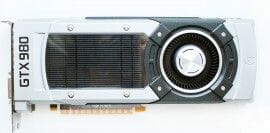
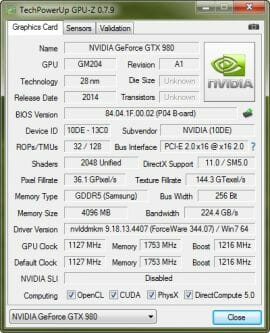
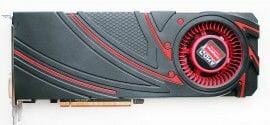
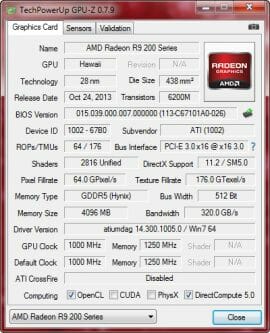
We’ll also throw in two original cards: an ASUS STRIX GTX 780 OC Edition and an EVGA GeForce GTX 770 Superclocked ACX.
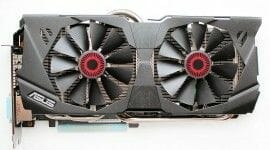
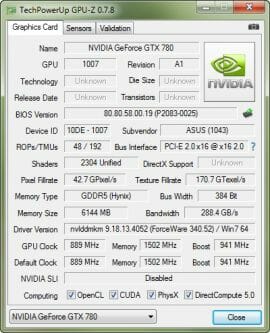
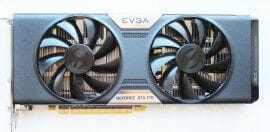
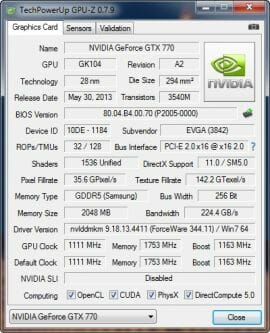
There are lots of original pre-overclocked graphics cards on the market right now, so we guess the new MSI GeForce GTX 970 Gaming should be pitted against such products without lowering their clock rates down to the level of reference models of the previous generation. We set Power Limit at its maximum on each graphics card.
In order to lower the dependence of the graphics cards’ performance on the overall platform speed, we overclocked our 32nm six-core CPU to 4.8 GHz by setting its frequency multiplier at x48 and enabling Load-Line Calibration. The CPU voltage was increased to 1,380 volts in the mainboard’s BIOS.
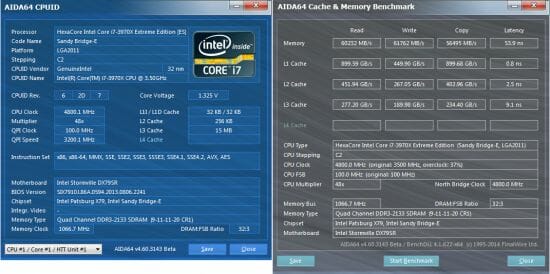
Hyper-Threading was turned on. We used 32 GB of system memory at 2.133 GHz with timings of 9-11-11-20_CR1 and voltage of 1.6125 volts.
The testbed ran Microsoft Windows 7 Ultimate x64 SP1 with all critical updates installed. We used the following drivers:
- Intel Chipset Drivers – 10.0.22 WHQL dated 05.08.2014
- DirectX End-User Runtimes, dated 30 November 2010
- Nvidia GeForce 344.11 WHQL dated 18.09.2014
- AMD Catalyst 14.x Beta (14.300.1005.0) dated 27.08.2014
By the way, the AMD Radeon R9 290X has become slightly yet consistently faster across most of our tests with the new beta version of the Catalyst driver.
We benchmarked the graphics cards’ performance at two display resolutions: 1920×1080 and 2560×1440 pixels. There were two visual quality modes: “Quality+AF16x” means the default texturing quality in the drivers + 16x anisotropic filtering whereas “Quality+ AF16x+MSAA 4x(8x)” means 16x anisotropic filtering and 4x or 8x antialiasing. In some games we use antialiasing algorithms other than MSAA as indicated below and in the diagrams. We enabled anisotropic filtering and full-screen antialiasing from the game’s menu. If the corresponding options were missing, we changed these settings in the Control Panels of the Catalyst and GeForce drivers. We also disabled V-Sync there. There were no other changes in the driver settings.
The graphics cards were tested in two benchmarks and 14 games updated to the latest versions. Particularly, Company of Heroes 2, Total War: Rome II, Thief and GRID Autosport have got new patches. Here’s the full list of our tests (the games are sorted in the order of their release).
- 3DMark (2013) (DirectX 9/11) version 1.3.708: Cloud Gate, Fire Strike and Fire Strike Extreme scenes.
- Unigine Valley Bench (DirectX 11) version 1.0: Maximum visual quality settings, 16x AF and/or 4x MSAA, 1920×1080.
- Total War: SHOGUN 2 – Fall of the Samurai (DirectX 11) version 1.1.0: integrated benchmark (the Sekigahara battle) with maximum visual quality settings and 8x MSAA.
- Sniper Elite V2 Benchmark (DirectX 11) version 1.05: Adrenaline Sniper Elite V2 Benchmark Tool v1.0.0.2 BETA with maximum graphics quality settings (“Ultra” profile), Advanced Shadows: HIGH, Ambient Occlusion: ON, Stereo 3D: OFF, Supersampling: OFF, two sequential runs of the test.
- Sleeping Dogs (DirectX 11) version 1.5: Adrenaline Sleeping Dogs Benchmark Tool v1.0.2.1 with maximum image quality settings, Hi-Res Textures pack installed, FPS Limiter and V-Sync disabled, two consecutive runs of the built-in benchmark with quality antialiasing at Normal and Extreme levels.
- Hitman: Absolution (DirectX 11) version 1.0.447.0: built-in test with Ultra settings, enabled tessellation, FXAA and global lighting.
- Crysis 3 (DirectX 11) version 1.2.0.1000: maximum visual quality settings, Motion Blur – Medium, lens flares – on, FXAA and MSAA 4x, two consecutive runs of a scripted scene from the beginning of the “Swamp” mission (110 seconds long).
- Tomb Raider (2013) (DirectX 11) version 1.1.748.0: we used Adrenaline Benchmark Tool, all image quality settings set to “Ultra”, V-Sync disabled, FXAA and 2x SSAA antialiasing enabled, TessFX technology activated, two consecutive runs of the in-game benchmark.
- BioShock Infinite (DirectX 11) version 1.1.25.5165: we used Adrenaline Action Benchmark Tool with “Ultra” and “Ultra+DOF” quality settings, two consecutive runs of the in-game benchmark.
- Metro: Last Light (DirectX 11) version 1.0.0.15: we used the built-in benchmark for two consecutive runs of the D6 scene. All image quality and tessellation settings were at “Very High”, Advanced PhysX technology enabled, with and without SSAA antialiasing.
- Company of Heroes 2 (DirectX 11) version 3.0.0.15370: two consecutive runs of the integrated benchmark at maximum image quality and physics effects settings.
- Total War: Rome II (DirectX 11) version 2.0.0.0: Extreme quality, V-Sync disabled, SSAA enabled, two consecutive runs of the integrated benchmark.
- Batman: Arkham Origins (DirectX 11) version 1.0 update 8: Ultra visual quality, V-Sync disabled, all the effects enabled, all DX11 Enhanced features enabled, Hardware Accelerated PhysX = Normal, two consecutive runs of the in-game benchmark.
- Battlefield 4 (DirectX 11) – version 111433: Ultra settings, two successive runs of a scripted scene from the beginning of the “Tashgar” mission (110 seconds long), with the Mantle API enabled for AMD-based cards.
- Thief (DirectX 11) version 1.6 build 4158.14: Maximum visual quality settings, Parallax Occlusion Mapping and Tessellation enabled, a double run of the in-game benchmark with the Mantle API enabled for AMD-based cards.
- GRID Autosport (DirectX 11) version 1.101.7026: the visual quality settings were all at their maximums, the tests were run with and without 8x MSAA with ten cars on the San Francisco track.
We publish the bottom frame rate for games that report it. Each test was run twice, the final result being the best of the two if they differed by less than 1%. If we had a larger difference, we reran the test at least once again to get repeatable results.
Performance
The results of the two Nvidia-based previous-generation cards, ASUS STRIX GTX 780 OC Edition and EVGA GeForce GTX 770 Superclocked ACX, are colored light-green. Those of the AMD-based Radeon R9 290X are red. The colors of the MSI GeForce GTX 970 Gaming and Nvidia GeForce GTX 980 are turquoise and dark-blue, respectively.
We’ll start out with semisynthetic benchmarks.
3DMark (2013)
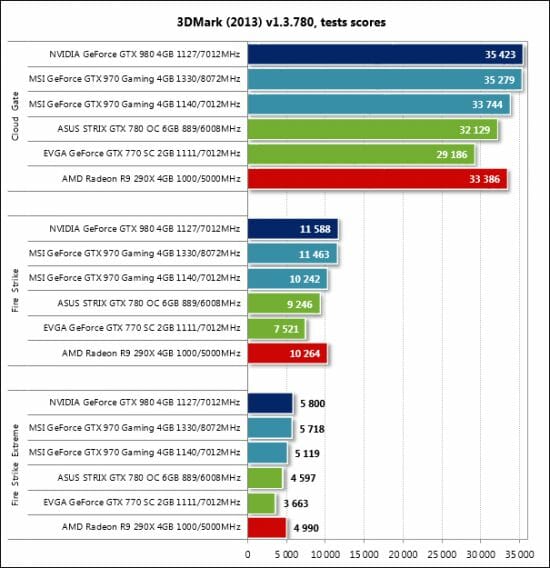
The MSI GeForce GTX 970 Gaming is quite fast in 3DMark. It is over 40% ahead of its predecessor GeForce GTX 770 (which is represented by an original pre-overclocked model) and even beats the GeForce GTX 780. It is also equal to AMD’s single-processor flagship Radeon R9 290X. Working at its default clock rates, the MSI is 10 to 12% behind the Nvidia GeForce GTX 980 but the gap can be bridged through overclocking. So far so good for the new graphics card.
Unigine Valley Bench
Our second semisynthetic benchmark produces a somewhat different picture:
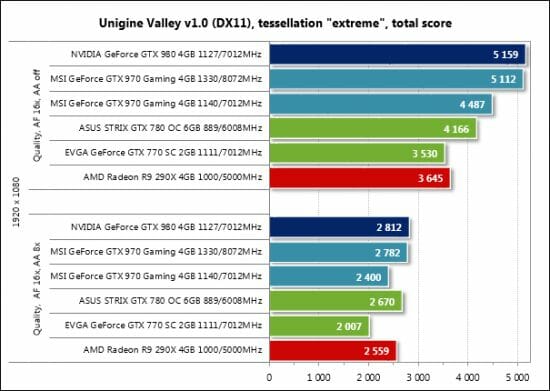
With antialiasing turned off, the MSI GeForce GTX 970 Gaming is still faster than the ASUS STRIX GTX 780 OC, but the latter goes ahead with 8x MSAA thanks to its broader memory bus and higher memory bandwidth. It has the same position relative to the other graphics cards, though. It must be noted that the AMD Radeon R9 290X did very well with antialiasing enabled.
Total War: Shogun 2 – Fall of the Samurai
We start our gaming tests with a good old real-time strategy.
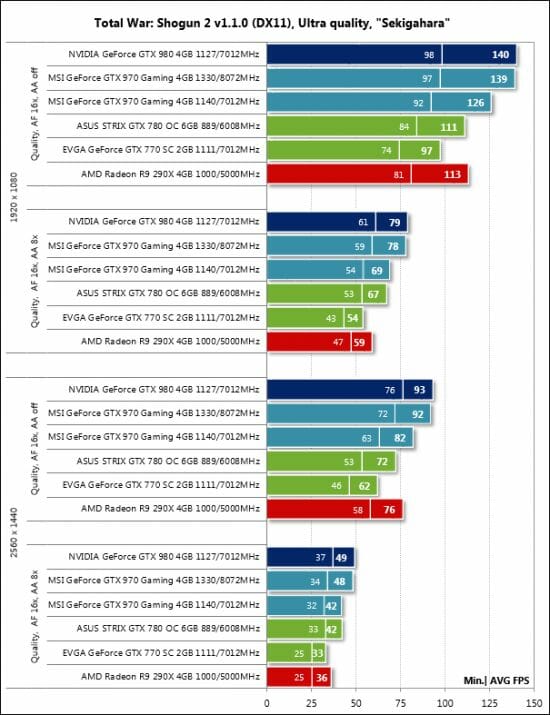
The Nvidia-based cards have what standings we could expect them to have basing on their market positioning. The MSI GeForce GTX 970 Gaming ensures a 30% performance boost in comparison with the factory-overclocked GeForce GTX 770. It is also up to 14% faster than the ASUS STRIX GTX 980 OC and 8 to 17% faster than the AMD Radeon R9 290X. So, the new card beats its predecessor and potential competitors and isn’t much slower than Nvidia’s flagship: the 14% gap from the GeForce GTX 980 can be easily narrowed by means of overclocking.
Sniper Elite V2 Benchmark
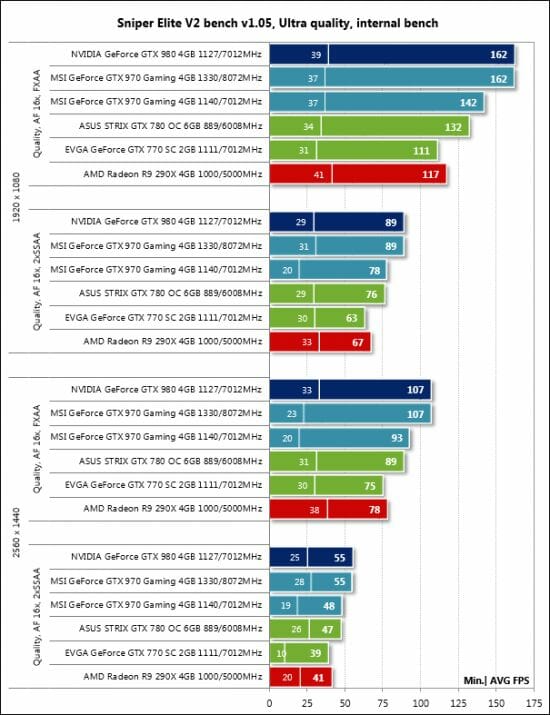
The Sniper Elite V2 results are no different from what we’ve seen in the previous test except that the AMD Radeon R9 290X loses its ground and can only compete with the GeForce GTX 770.
Sleeping Dogs
This game produces typical standings for this test session:
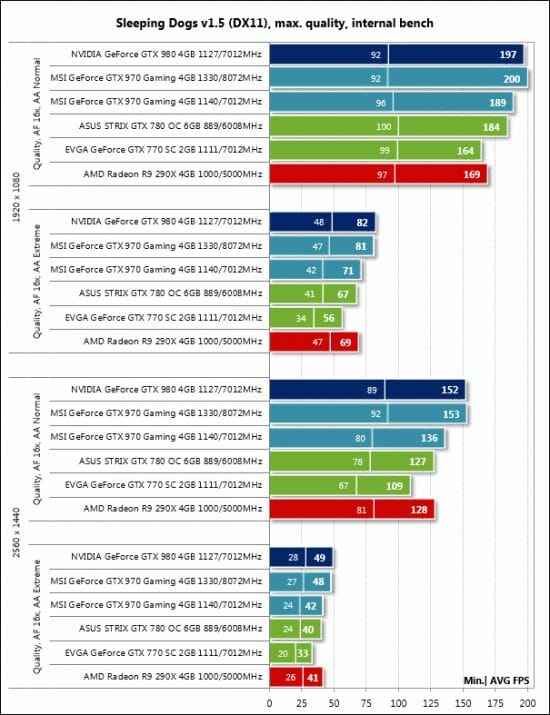
In the hardest mode the MSI GeForce GTX 970 Gaming leaves the EVGA GeForce GTX 770 SC behind by 27%, beats the ASUS STRIX GTX 780 OC by 6-7% and matches the performance of the AMD Radeon R9 290X. Overclocking the MSI to 1330/8072 MHz ensures the same speed as with the reference Nvidia GeForce GTX 980 but at the default clock rates there’s a 4 to 14% gap between them.
Hitman: Absolution
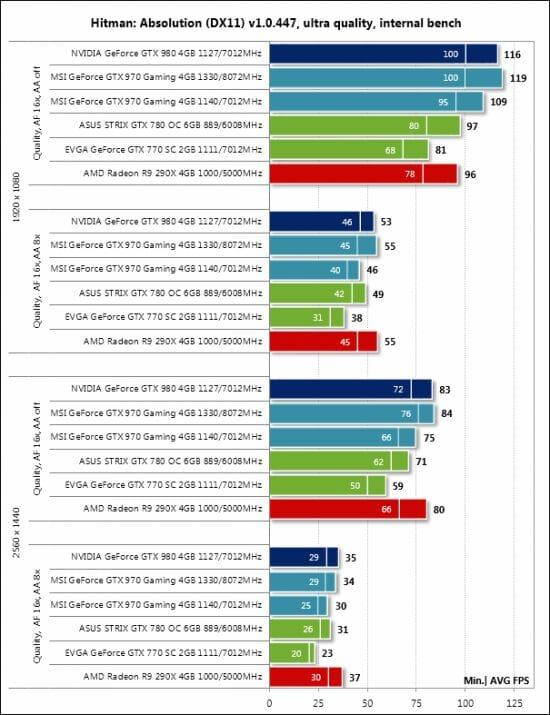
This is one of the few games in this test session where the AMD Radeon R9 290X, which has become considerably cheaper in the recent months, is faster than the MSI GeForce GTX 970 Gaming. Moreover, the AMD-based flagship can challenge the Nvidia GeForce GTX 980 at the hardest settings. On the other hand, we can note that the MSI is superior to the EVGA GeForce GTX 770 SC and equal in speed to the ASUS STRIX GTX 780 OC. Its excellent performance scalability at overclocking even makes the reference GeForce GTX 980 look not so very fast.
Crysis 3
We have somewhat different results in Crysis 3.
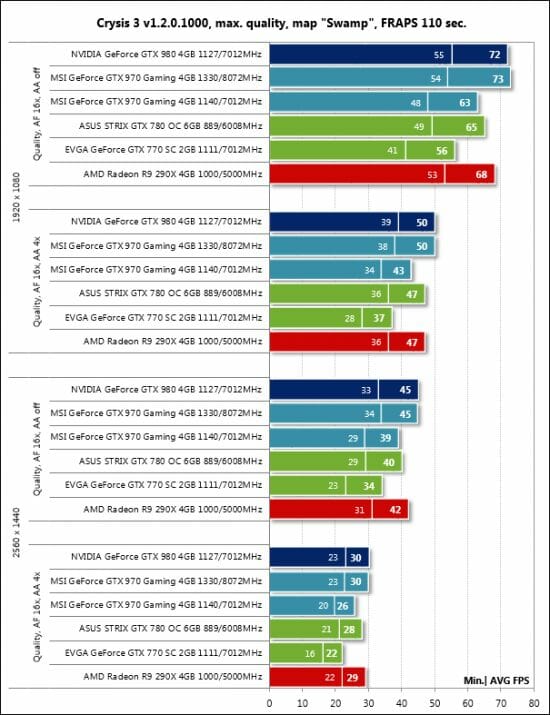
The MSI GeForce GTX 970 Gaming isn’t as much faster than the factory-overclocked GeForce GTX 770 as in the previous tests: only up to 18%. The new card is also somewhat slower than the ASUS STRIX GTX 780 OC across all the test modes and resolutions and falls behind the AMD Radeon R9 290X. Overclocking boosts its performance, so it wins a joint first place with the GeForce GTX 980. The latter may be overclocked as well, of course, but we’ll talk about that in our next review.
Tomb Raider (2013)
Here, the new card from MSI is again up to 30% faster than the EVGA GeForce GTX 770 SC and a little better than the ASUS STRIX GTX 780 OC.
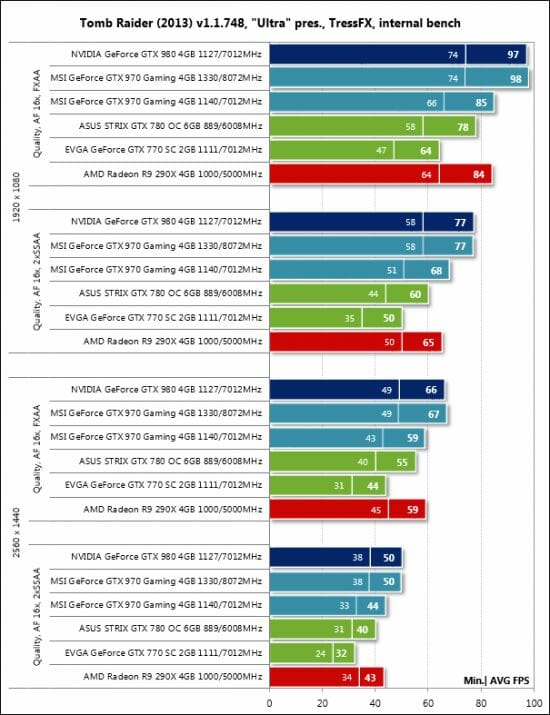
Being quite inexpensive now, the reference AMD Radeon R9 290X offers the same performance, though. The Nvidia GeForce GTX 980 is 10-12% ahead of the MSI GeForce GTX 970 Gaming but the latter overtakes the former when overclocked.
BioShock Infinite
The integrated BioShock Infinite benchmark once again has a very low bottom frame rate on the Nvidia-based cards, as opposed to the AMD-based ones.
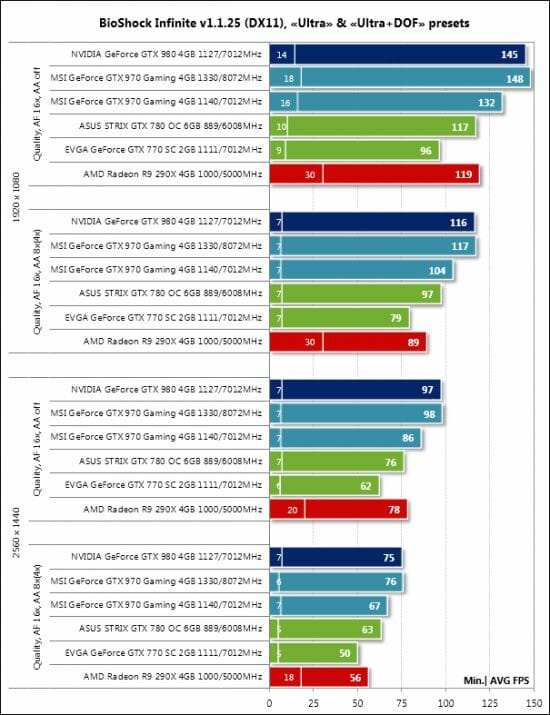
When it comes to average frame rates, the GeForce series is quite fast whereas the AMD Radeon R9 290X is somewhere in between the EVGA GeForce GTX 770 SC and the ASUS STRIX GTX 780 OC.
Metro: Last Light
With the Advanced PhysX option enabled, the AMD Radeon R9 290X just has no chances. This test is won by the overclocked MSI GeForce GTX 970 Gaming.
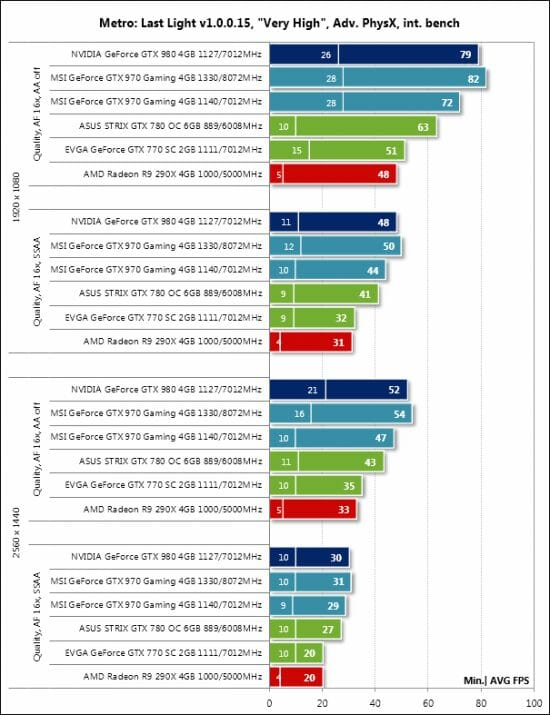
Things take a different turn when Advanced PhysX is disabled.
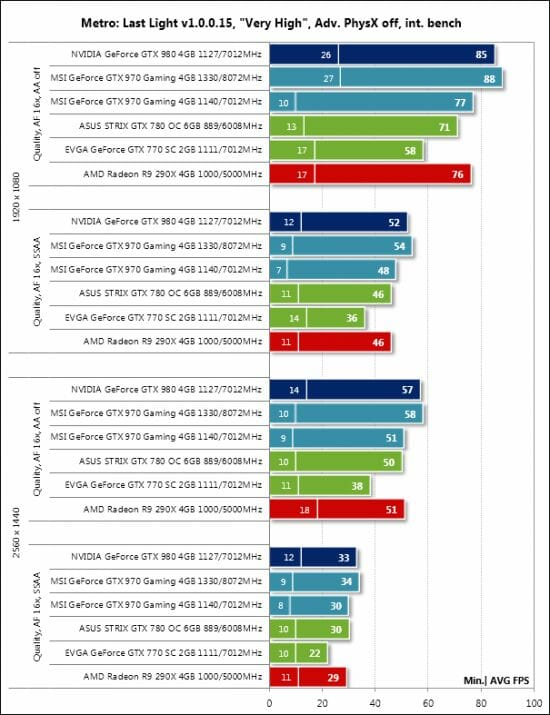
Anyway, the MSI GeForce GTX 970 Gaming is just as good as the AMD Radeon R9 290X and outperforms the pre-overclocked GeForce GTX 770 from EVGA as well as ASUS’s STRIX GTX 780 OC. When overclocked, the MSI card easily overtakes the reference GTX 980.
Company of Heroes 2
AMD-based cards are hard to beat in this game as our today’s results indicate.
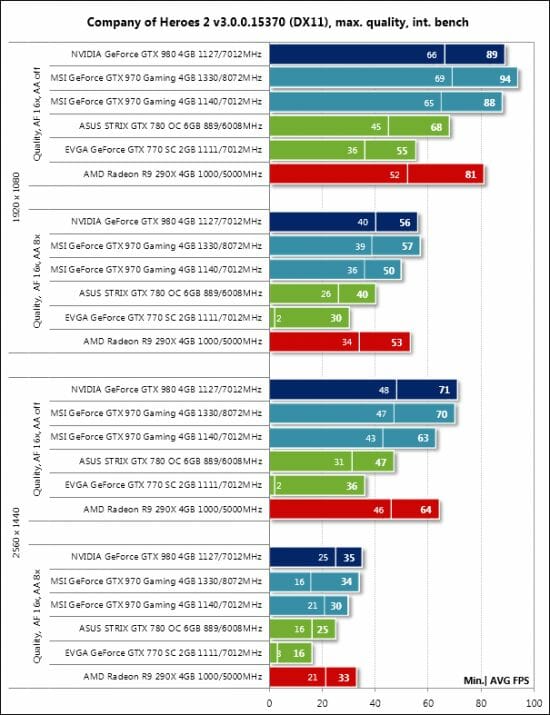
The progress between Nvidia’s GPUs can be seen clearly here: the gaps between the Nvidia-based solutions are the same size from the EVGA GeForce GTX 770 SC upwards to the Nvidia GeForce GTX 980 (or to the overclocked MSI GeForce GTX 970 Gaming).
Total War: Rome II
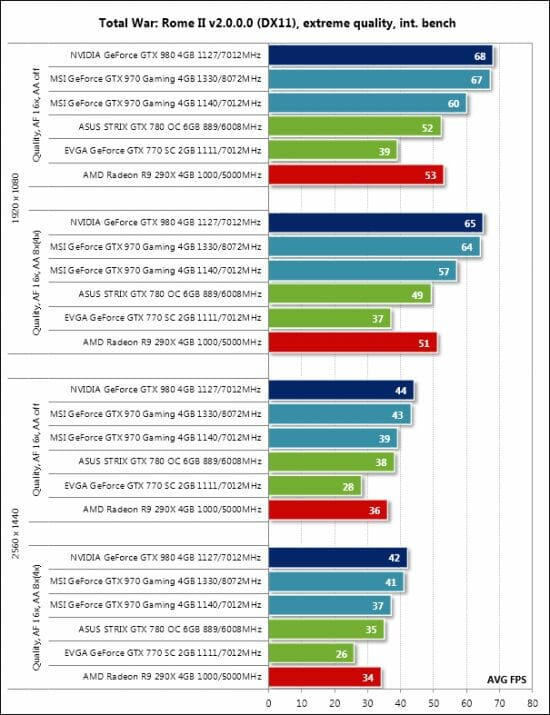
The new card from MSI is 39-54% faster than the EVGA GeForce GTX 770 SC and 3-16% ahead of the ASUS STRIX GTX 780 OC and AMD Radeon R9 290X. The 9-17% gap from the reference Nvidia GeForce GTX 980 can be eliminated by means of overclocking.
Batman: Arkham Origins
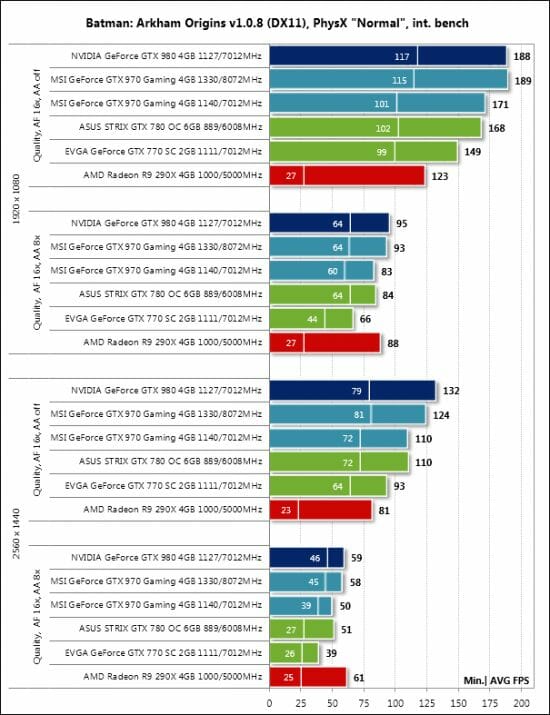
This game doesn’t produce any unexpected results.
Battlefield 4
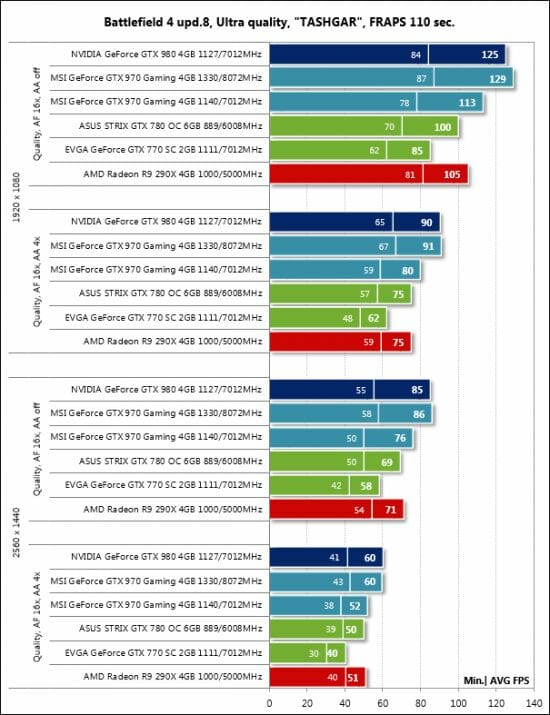
The Battlefield 4 standings are quite typical of this test session, too.
Thief
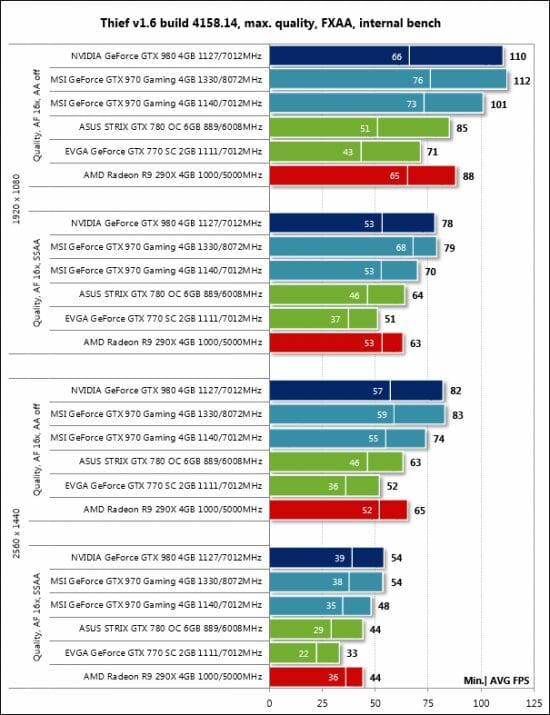
This game agrees with the previous tests.
GRID Autosport
This racing sim runs fast on any of the tested graphics cards, yet the GeForce GTX 980 and the overclocked MSI GeForce GTX 970 Gaming would ensure the most comfortable gameplay.
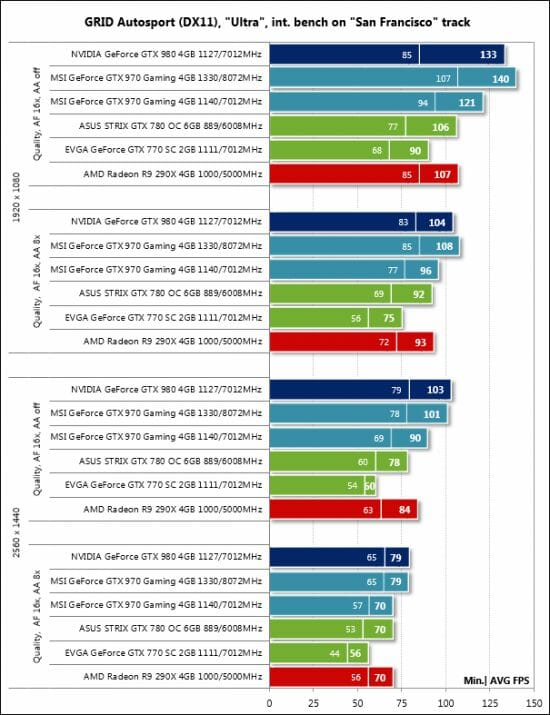
The difference between the individual cards is largely the same as in the previous tests.
Our test results are summed up in the following table where the average and minimum speed are indicated for each graphics card.
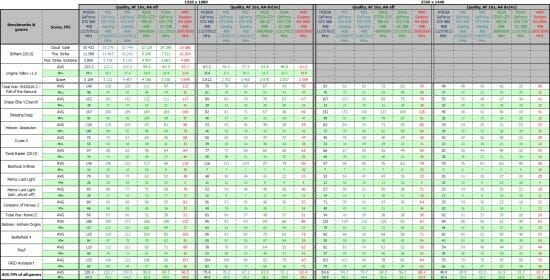
And now we can move on to our summary charts.
Performance Summary Charts
First of all, let’s check out the difference between the MSI GeForce GTX 970 Gaming and the EVGA GeForce GTX 770 SC at their default clock rates. As their model numbers suggest, these are same-class solutions of two different generations. The EVGA card’s performance serves as the baseline in the diagrams below.
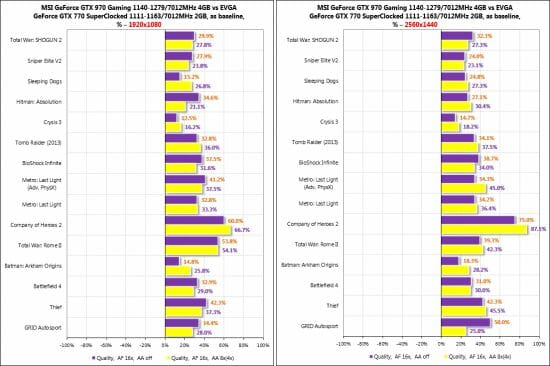
Announced over a year ago, the GeForce GTX 770 came at a recommended price of $399. The GeForce GTX 970, on its part, costs a recommended $329, ensuring a performance advantage of 33 to 35%. Sounds good even if we do not take any other advantages into account.
Besides beating one of the fastest factory-overclocked versions of the GTX 770, the MSI GeForce GTX 970 Gaming has no problem outperforming the ASUS STRIX GTX 780 OC with its 6 gigabytes of onboard memory. Here are the diagrams:
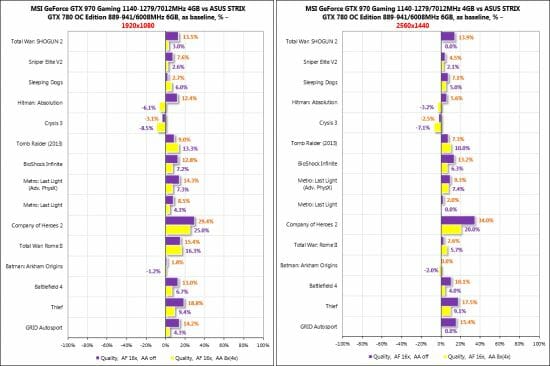
It is only in one test mode of Hitman: Absolution, in Crysis 3 and Batman: Arkham Origins that the new card can’t cope with its opponent. In the rest of the tests the MSI is an average 6 to 11% ahead at 1920×1080 and 3.8 to 9.3% ahead at 2560×1440.
We have the same picture comparing the MSI GeForce GTX 970 Gaming with the AMD Radeon R9 290X.
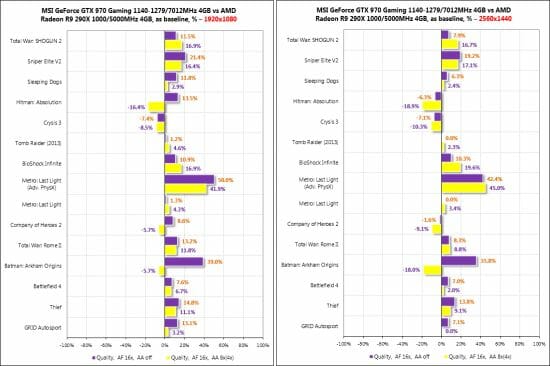
The MSI is slower than its opponent in Company of Heroes 2 besides the other abovementioned titles, but that’s not too many games anyway. We should note that the Radeon R9 290X has become cheaper, so this comparison isn’t quite correct in terms of pricing.
And now let’s compare the MSI GeForce GTX 970 Gaming with the reference Nvidia GeForce GTX 980.
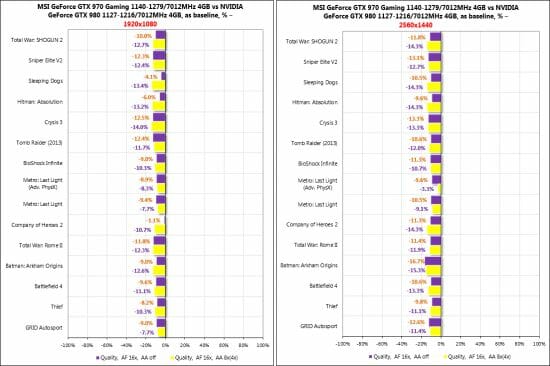
The new card is 9 to 12% slower across all the tests but the GTX 980 is 67% more expensive in terms of their recommended prices ($549 and $329).
We managed to overclock the MSI card’s GPU and memory by 16.2% and 14.8%, which made the card considerably faster in each of our tests as is proved by the next pair of diagrams.
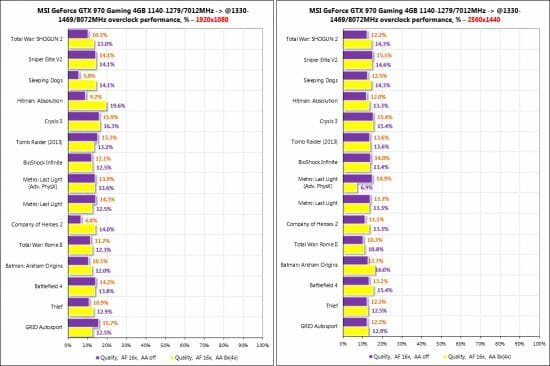
The MSI GeForce GTX 970 Gaming got 12-14% faster on average, delivering the same or even higher performance compared to the reference GTX 980.
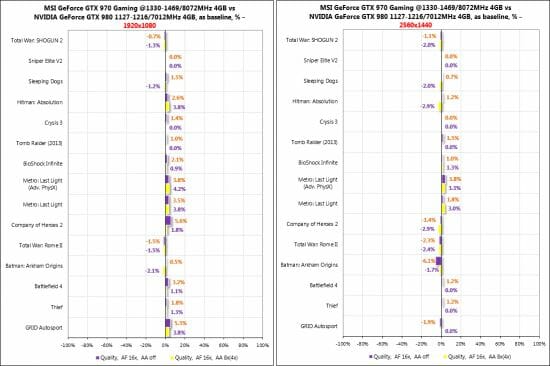
That’s just an excellent reward for our overclocking efforts.
Power ConsumptionWe measured the power consumption of computer systems with different graphics cards using a multifunctional panel Zalman ZM-MFC3 which can report how much power a computer (the monitor not included) draws from a wall socket. There were two test modes: 2D (editing documents in Microsoft Word and web surfing) and 3D (the intro scene of the Swamp level from Crysis 3 running four times in a loop at 2560×1440 with maximum visual quality settings but without MSAA). Here are the results:
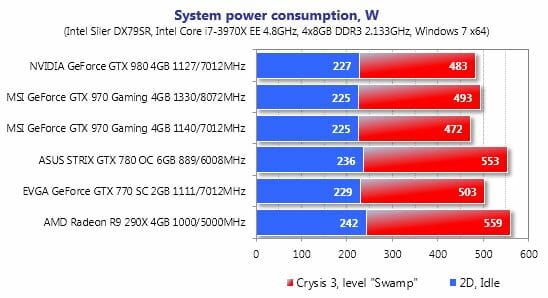
The configuration with MSI GeForce GTX 970 Gaming turned out to be the most economical in this test. Its average power draw was about 450 watts with a maximum of 472 watts. Interestingly, the much weaker EVGA GeForce GTX 770 SC needs 30 watts more, so the progress between the two GPU generations is obvious. The new GTX 970 looks even better in comparison with the GTX 780 and Radeon R9 290X, requiring 81 and 87 watts less at peak load. The reference GeForce GTX 980 is impressive as well. Its configuration is comparable to the MSI one in power consumption. When the MSI card is overclocked, its power draw increases by a mere 21 watts at peak load.
ConclusionThe MSI GeForce GTX 780 Gaming delivers unprecedented performance for its class. It is much faster than the previous-generation GeForce GTX 770 it has come to replace and is available at a lower initial recommended price. The impressive overclocking potential of the new GM204 processor with Maxwell architecture and the high-speed memory help make the MSI card as fast as the flagship GTX 980 model or even better. Considering that the GTX 970 is less expensive, we guess it is going to be far more popular than the GTX 980.
Of course, MSI should also be given credit for equipping this graphics card with high-quality components and the advanced Twin Frozr V cooler which is very efficient and has an extremely low level of noise. We could never achieve such overclocking results with top-end graphics cards using just basic air cooling. The rather low power requirements of the new card must also be noted among its advantages. We’d recommend it to everyone as soon as it hits the stores.